A complex relationship between all the living and nonliving things (plants, animals, organisms, sun, water, climate etc)interact with each other is known as ‘An Ecosystem’. Ecosystems are the foundation of ‘Biosphere’ and maintain the natural balance of the earth.
For example, let’s take the relationship between sheep and lion in the ecosystem; for its survival, the lion eats the sheep. And each relationship like this has an effect on other creatures and plants living in the same area.
Hence, if the lion eats more sheep, it has an effect on the plants too; they begin to flourish; since there aren’t many sheep to eat the plants.
Each organism in the ecosystem plays an important role, so anytime a ‘foreign’ factor is put in the ecosystem, it poses a major threat to the ecosystem. This happens because the foreign factor can deform the natural balance of the ecosystem and harm it potentially.
This foreign factor could be anything ranging from rising temperature to the tsunami. Not just the foreign factor but man-made can also destroy the ecosystem.
What is Ecosystem?
- The term ecosystem was coined by Sir Arthur Tansley in 1935.
- An ecosystem can be visualised as a functional unit of nature, where living organisms interact among themselves and also with the surrounding physical environment.
- Ecosystem varies greatly in size from a small pond to a large forest or a sea. Many ecologists regard the entire biosphere as a global ecosystem, as a composite of all local ecosystems on Earth.
- Since this system is too much big and complex to be studied at one time, it is convenient to divide it into two basic categories, namely the terrestrial and the aquatic. Forest, grassland and desert are some examples of terrestrial ecosystems; pond, lake, wetland, river and estuary are some examples of aquatic ecosystems. Crop fields and an aquarium may also be considered as man-made ecosystems.
- First look at the structure of the ecosystem, in order to appreciate the input (productivity), transfer of energy (food chain/web, nutrient cycling) and the output (degradation and energy loss), then look at the relationships – cycles, chains, webs – that are created as a result of these energy flows within the system and their inter- relationship.
An ecosystem has two basic components:
-
Biotic components include producers, consumers and decomposers.
-
Abiotic components comprise inorganic materials (e.g., carbon, nitrogen, oxygen, CO2, water, etc.) and dead organic matter containing proteins, carbohydrates, lipids, humic substance, etc. Abiotic substances are present in soil, water and air. The climatic parameters like solar radiation and temperature determine the abiotic conditions within which the organisms carry out life functions
- Producers are the autotrophs, which produce their own food. A variety of photosynthetic bacteria, chemosynthetic bacteria and photosynthetic protozoa also produce organic substances in terrestrial and aquatic habitats, though in very small amounts. In terrestrial ecosystems, the autotrophs are usually rooted plants (herbs, shrubs and trees), whereas in deep aquatic ecosystems, floating plants called phytoplankton are the major autotrophs. In shallow waters rooted plants, macrophytes, are the dominant producers. When the environmental conditions are optimum, the phytoplankton may produce as much food as produced by the larger shrubs and trees on unit area (land or water surface) basis.
- Consumers or phagotrophs or heterotrophs: A consumer, which derives nutrition by eating plants, is called primary consumer or herbivore. The secondary consumer or carnivore is an animal that depends upon the flesh of herbivore or other animals.
- Decomposers or saprotrophs consisting mostly of bacteria and fungi, which live on dead organic matter or detritus, the decomposers do not ingest their food. Instead, they release different enzymes from their bodies into the dead and decaying plant and animal remains. The extra cellular digestion of the dead remains, leads to the release of simpler inorganic substances, which are then, utilized by the decomposers. The producers from the first trophic level, herbivores the second, and carnivores constitute and third.
Components of the Ecosystem
The components of an ecosystem are divided into abiotic components, that include all non-living components such as minerals, climate, soil, water, sunlight and biotic components, that include all the living components. These components together make up for the flow of energy in the ecosystem and the nutrient cycle in the ecosystem.
The gleaming energy from the sun is the basic source of energy in all the ecosystems. The autotrophs (self-sustaining organisms) absorb this energy and produce photosynthesis where they can use this energy to convert CO2 and H2O into simple carbohydrates.
The autotrophs store energy in these carbohydrates, which they then use to produce more complex and organic products like lipids, proteins, and starches that help the organism to survive. These autotrophs are the producers of the ecosystem. Organic compounds produced by autotrophs help in the survival of the heterotrophic organisms. And heterotrophs are the consumers of the ecosystem since they’re incapable of making their own food. All organisms like bacteria, fungi or animals are heterotrophs.
Types of Ecosystems
An ecosystem consists of three types of ecosystems, another term for which is ‘Biomes’. The three major types are:
- Aquatic biomes
- Terrestrial biomes
Trophic Levels, Food Chain and Food Web
The nutritive levels in a food chain are known as Trophic Levels. The organisms in the trophic levels of the food chain are categorized based on their feeding patterns.
- Producers (green plants) make for the lowest level of the chain.
- Consumption of the by-products of these producers by the herbivores or the primary consumers makes for the second-level.
- Next, the consumption of these herbivores by carnivore or the tertiary consumers makes for the third-level. Additionally, omnivores ( organisms that consume plants and animals both) as well come at the third level.
- Quaternary consumers consist of organisms that eat these carnivores.
- Lastly, decomposers make up for a completely different level of the food chain alongside the given levels. These decomposers help in breaking waste materials and convert them into nutrients which is useful for the producers.
Ecosystem – Structure and Functions
In earlier topic we studied various components of the environment- abiotic and biotic, and also studied how the individual biotic and abiotic factors affected each other and their surrounding. Now look at these components in a more integrated manner and see how the flow of energy takes place within these components of the ecosystem.
Interaction of biotic and abiotic components result in a physical structure that is characteristic for each type of ecosystem. Identification and enumeration of plant and animal species of an ecosystem gives its species composition. Vertical distribution of different species occupying different levels is called stratification. For example, trees occupy top vertical strata or layer of a forest, shrubs the second and herbs and grasses occupy the bottom layers.
The components of the ecosystem are seen to function as a unit when we consider the following aspects:
- Productivity
- Decomposition
- Energy flow
- Nutrient cycling.
Pond Ecosystem
- To understand an aquatic ecosystem let us take a small pond as an example. This is fairly a self-sustainable unit and rather simple example that explain even the complex interactions that exist in an aquatic ecosystem.
- A pond is a shallow water body in which all the above mentioned four basic components of an ecosystem are well exhibited.
- The abiotic component is the water with all the dissolved inorganic and organic substances and the rich soil deposit at the bottom of the pond. The solar input, the cycle of temperature, day-length and other climatic conditions regulate the rate of function of the entire pond.
- The autotrophic components include the phytoplankton, some algae and the floating, submerged and marginal plants found at the edges.
- The consumers are represented by the zooplankton, the free swimming and bottom dwelling forms.
- The decomposers are the fungi, bacteria and flagellates especially abundant in the bottom of the pond.
- This system performs all the functions of any ecosystem and of the biosphere as a whole, i.e., conversion of inorganic into organic material with the help of the radiant energy of the sun by the autotrophs; consumption of the autotrophs by heterotrophs; decomposition and mineralisation of the dead matter to release them back for reuse by the autotrophs, these event are repeated over and over again.
- There is unidirectional movement of energy towards the higher trophic levels and its dissipation and loss as heat to the environment.
PRODUCTIVITY
- A constant input of solar energy is the basic requirement for any ecosystem to function and sustain. Primary production is defined as the amount of biomass or organic matter produced per unit area over a time period by plants during photosynthesis. It is expressed in terms of weight (g–2) or energy (kcal m–2).
- The rate of biomass production is called productivity. It is expressed in terms of g –2 yr–1 or (kcal m–2) yr–1 to compare the productivity of different ecosystems. It can be divided into gross primary productivity (GPP) and net primary productivity (NPP).
- Gross primary productivity of an ecosystem is the rate of production of organic matter during photosynthesis. A considerable amount of GPP is utilised by plants in respiration. Gross primary productivity minus respiration losses (R), is the net primary productivity (NPP).
GPP – R = NPP
- Net primary productivity is the available biomass for the consumption to heterotrophs (herbiviores and decomposers). Secondary productivity is defined as the rate of formation of new organic matter by consumers.
- Primary productivity depends on the plant species inhabiting a particular area. It also depends on a variety of environmental factors, availability of nutrients and photosynthetic capacity of plants. Therefore, it varies in different types of ecosystems. The annual net primary productivity of the whole biosphere is approximately 170 billion tons (dry weight) of organic matter. Of this, despite occupying about 70 per cent of the surface, the productivity of the oceans are only 55 billion tons. Rest of course, is on land.
Decomposition
- Earthworm is often referred to as the farmer’s ‘friend’, this is so because they help in the breakdown of complex organic matter as well as in loosening of the soil. Similarly, decomposers break down complex organic matter into inorganic substances like carbon dioxide, water and nutrients and the process is called decomposition.
- Dead plant remains such as leaves, bark, flowers and dead remains of animals, including fecal matter, constitute detritus, which is the raw material for decomposition. The important steps in the process of decomposition are fragmentation, leaching, catabolism, humification and mineralisation.
- Detritivores (e.g., earthworm) break down detritus into smaller particles. This process is called fragmentation.
- By the process of leaching, water- soluble inorganic nutrients go down into the soil horizon and get precipitated as unavailable salts.
- Bacterial and fungal enzymes degrade detritus into simpler inorganic substances. This process is called as catabolism
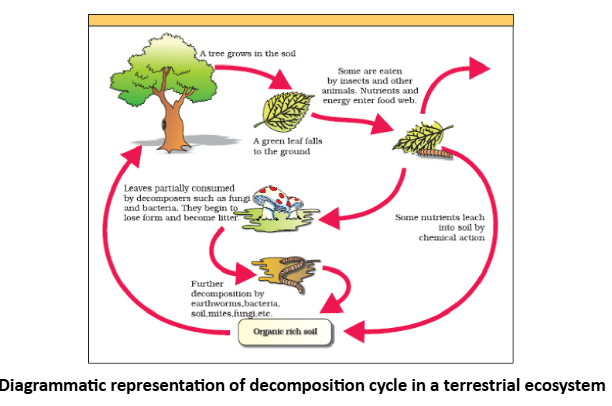
It is important to note that all the above steps in decomposition operate simultaneously on the detritus.
- Humification and to accumulation of a dark coloured amorphous substance called humus that is highly resistant to microbial action and undergoes decomposition at an extremely slow rate. Being colloidal in nature it serves as a reservoir of nutrients.
- The humus is further degraded by some microbes and release of inorganic nutrients occur by the process known as mineralisation.
- Decomposition is largely an oxygen-requiring process. The rate of decomposition is controlled by chemical composition of detritus and climatic factors.
- In a particular climatic condition, decomposition rate is slower if detritus is rich in lignin and chitin, and quicker, if detritus is rich in nitrogen and water-soluble substances like sugars.
- Temperature and soil moisture are the most important climatic factors that regulate decomposition through their effects on the activities of soil microbes. Warm and moist environment favour decomposition whereas low temperature and anaerobiosis inhibit decomposition resulting in build up of organic materials.
Energy Flow
- Except for the deep sea hydro-thermal ecosystem, sun is the only source of energy for all ecosystems on Earth. Of the incident solar radiation less than 50 per cent of it is photosynthetically active radiation (PAR).
- Plants and photosynthetic and chemosynthetic bacteria (autotrophs), fix sun’s radiant energy to make food from simple inorganic materials. Plants capture only 2-10 per cent of the PAR and this small amount of energy sustains the entire living world. So, it is very important to know how the solar energy captured by plants flows through different organisms of an ecosystem. All organisms are dependent for their food on producers, either directly or indirectly. So unidirectional flow of energy from the sun to producers and then to consumers takes place. (First law of thermodynamics)
- Further, ecosystems are not exempt from the Second Law of thermodynamics. They need a constant supply of energy to synthesise the molecules they require, to counteract the universal tendency toward increasing disorderliness.
- The green plant in the ecosystem-terminology are called producers.In a terrestrial ecosystem, major producers are herbaceous and woody plants. Likewise, primary producers in an aquatic ecosystem are various species like phytoplankton, algae and higher plants.
- Starting from the plants (or producers) food chains or rather webs are formed such that an animal feeds on a plant or on another animal and in turn is food for another. The chain or web is formed because of this interdependency. No energy that is trapped into an organism remains in it for ever. The energy trapped by the producer, hence, is either passed on to a consumer or the organism dies. Death of organism is the beginning of the detritus food chain/web.
- All animals depend on plants (directly or indirectly) for their food needs.
- They are hence called consumers and also heterotrophs. If they feed on the producers, the plants, they are called primary consumers, and if the animals eat other animals which in turn eat the plants (or their produce) they are called secondary consumers. Likewise, tertiary consumers too.
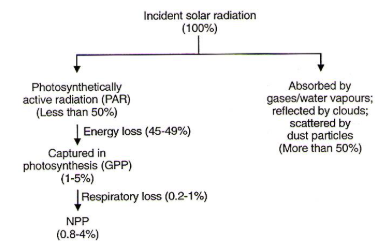
- Obviously the primary consumers will be herbivores. Some common herbivores are insects, birds and mammals in terrestrial ecosystem and molluscs in aquatic ecosystem.
- The consumers that feed on these herbivores are carnivores, or more correctly primary carnivores (though secondary consumers). Those animals that depend on the primary carnivores for food are labelled secondary carnivores. A simple grazing food chain (GFC) is depicted below:

- The detritus food chain (DFC) begins with dead organic matter. It is made up of decomposers which are heterotrophic organisms, mainly fungi and bacteria. They meet their energy and nutrient requirements by degrading dead organic matter or detritus. These are also known as saprotrophs (sapro: to decompose). Decomposers secrete digestive enzymes that breakdown dead and waste materials into simple, inorganic materials, which are subsequently absorbed by them.
- In an aquatic ecosystem, GFC is the major conduit for energy flow. As against this, in a terrestrial ecosystem, a much larger fraction of energy flows through the detritus food chain than through the GFC. Detritus food chain may be connected with the grazing food chain at some levels: some of the organisms of DFC are prey to the GFC animals, and in a natural ecosystem, some animals like cockroaches, crows, etc., are omnivores. These natural interconnection of food chains make it a food web.
- Organisms occupy a place in the natural surroundings or in a community according to their feeding relationship with other organisms. Based on the source of their nutrition or food, organisms occupy a specific place in the food chain that is known as their trophic level. Producers belong to the first trophic level, herbivores (primary consumer) to the second and carnivores (secondary consumer) to the third.
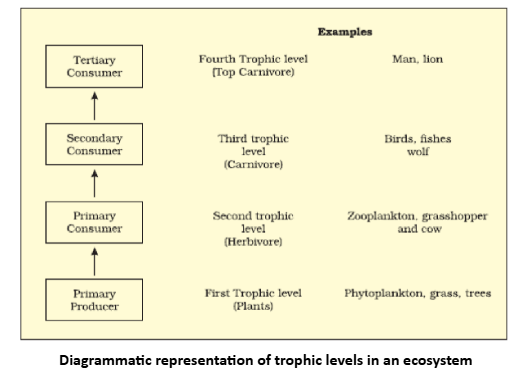
- The important point to note is that the amount of energy decreases at successive trophic levels.
- When any organism dies it is converted to detritus or dead biomass that serves as an energy source for decomposers.
- Organisms at each trophic level depend on those at the lower trophic level for their energy demands. Each trophic level has a certain mass of living material at a particular time called as the standing crop. The standing crop is measured as the mass of living organisms (biomass) or the number in a unit area. The biomass of a species is expressed in terms of fresh or dry weight. Measurement of biomass in terms of dry weight is more accurate.
- The number of trophic levels in the grazing food chain is restricted as the transfer of energy follows 10 per cent law – only 10 per cent of the energy is transferred to each trophic level from the lower trophic level. In nature, it is possible to have so many levels – producer, herbivore, primary carnivore, secondary carnivore in the grazing food chain.
- The productivity of each trophic level is much less than the productivity of the trophic level it feeds on. This is because some energy is lost as heat, some production is never eaten but goes into the detritus pool, and some of what is eaten passes through the gut and into the detritus pool as faeces. The percentage of the productivity of the trophic level, which enters the next trophic level, is called transfer efficiency. Transfer efficiencies are only about 10% i.e., the rate at which energy passes into each trophic level is about 10% of that entering the previous level. This is called the 10% law. (An American ecologist, Raymond L. Lindeman).
- Thus a sharp decline in productivity from one trophic level to the next sets the limit to the number of trophic levels. The maximum number of links found in food chains appears to be about seven, but food chains with between three to five links is common.
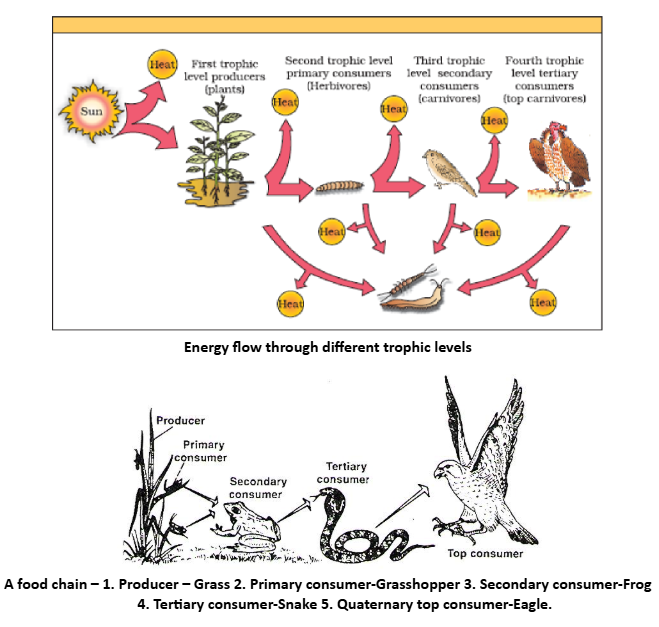
Ecological Pyramids
A pyramidal structure is obtained when food or energy relationship between organisms at different trophic level is expressed. Thus, relationship is expressed in terms of number, biomass or energy. The base of each pyramid represents the producers or the first trophic level while the apex represents tertiary or top level consumer. The three ecological pyramids that are usually studied are (a) pyramid of number; (b) pyramid of biomass and (c) pyramid of energy.
Pyramids of Numbers
These show the numbers of individuals at each trophic level. The length of each bar is proportional to the number of organisms. It was the British ecologist Charles Elton who is 1927, first recognized that such a diagrams often forms a pyramid. Pyramids of numbers are therefore sometimes referred to as Eltonian pyramids. In number pyramids there are fewer individuals in each higher trophic levels are (i) predators are generally larger than their prey, and (ii) at higher trophic levels, less energy enters, and so is distributed to fewer individuals.
However pyramid of numbers need not always be pyramid shaped. They could be bulged at the middle, when the producers are larger and few in number as in forest ecosystem or inverted when the consumer carry parasites.

Pyramids of Biomass
These show the dry weight of the organisms (the standing crop) in the trophic levels at a particular point of time. The length of the bars is proportional to the biomass in each level. Biomass represents the chemical energy stored in the organic matter of a trophic level. Biomass pyramids generally narrow sharply from producers at the bases to top-level carnivores at the apex because energy transfers between trophic levels are so inefficient. Some aquatic ecosystems, however, have inverted biomass pyramids, with primary consumers outweighing producers.
For example, the biomass of diatoms in a lake is very small, because the zooplankton consumes them so quickly that the producers never develop a large population size or standing crop. Instead, the phytoplankton (diatoms) has a high turnover rate. They grow, reproduce and are consumed rapidly. Nevertheless, productivity by the phytoplankton is fairly high, and the energy pyramid for this ecosystem is upright.

Pyramids of Energy
These are the most useful type of pyramids. The length of the bar represents the productivity of one trophic level in an ecosystem. These show how much energy passes from one trophic level to the next. Because only a proportion of energy in a level is transferred to the next, energy pyramids are never inverted nor do they have a central bulge.
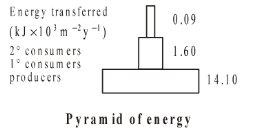
- Pyramid of numbers in a grassland ecosystem. Only three top-carnivores are supported in an ecosystem based on production of nearly 6 millions plant
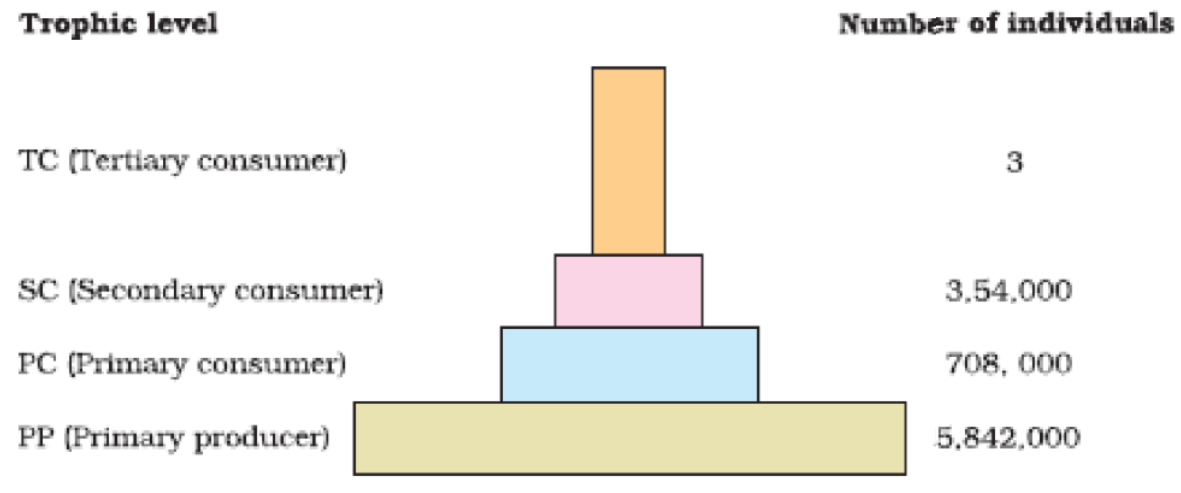
- Pyramid of biomass shows a sharp decrease in biomass at higher trophic levels
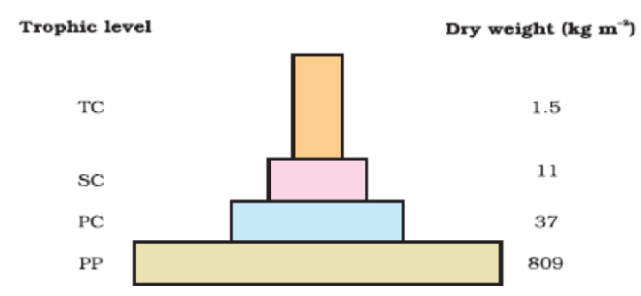
- Inverted pyramid of biomass-small standing crop of phytoplankton supports large standing crop of zooplankton
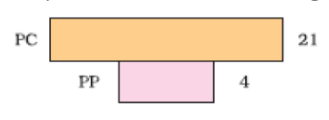
- An ideal pyramid of energy. Observe that primary producers convert only 1% of the energy in the sunlight available to them into NPP
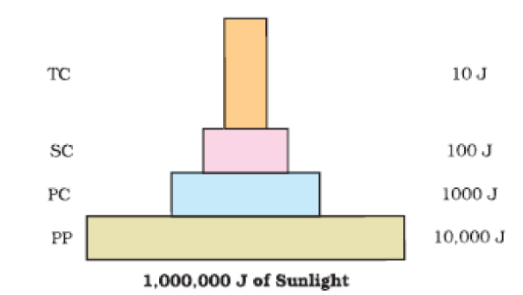
- Any calculations of energy content, biomass, or numbers has to include all organisms at that trophic level. No generalisations will be true if only a few individuals at any trophic level is taken into account.
- Also a given organism may occupy more than one trophic level simultaneously. One must remember that the trophic level represents a functional level, not a species as such. A given species may occupy more than one trophic level in the same ecosystem at the same time; for example, a sparrow is a primary consumer when it eats seeds, fruits, peas, and a secondary consumer when it eats insects and worms.
- In most ecosystems, all the pyramids, of number, of energy and biomass are upright, i.e., producers are more in number and biomass than the herbivores, and herbivores are more in number and biomass than the carnivores. Also energy at a lower trophic level is always more than at a higher level.
- There are exceptions to this generalisation: count the number of insects feeding on a big tree. Now add an estimate of the number of small birds depending on the insects, as also the number of larger birds eating the smaller.
- The pyramid of biomass in sea is also generally inverted because the biomass of fishes far exceeds that of phytoplankton.
- Pyramid of energy is always upright, can never be inverted, because when energy flows from a particular trophic level to the next trophic level, some energy is always lost as heat at each step.
- Each bar in the energy pyramid indicates the amount of energy present at each trophic level in a given time or annually per unit area.
- However, there are certain limitations of ecological pyramids such as it does not take into account the same species belonging to two or more trophic levels. It assumes a simple food chain, something that almost never exists in nature; it does not accommodate a food web. Moreover, saprophytes are not given any place in ecological pyramids even though they play a vital role in the ecosystem.
Ecological Efficiences
- Ratios between energy flow at different points along the food chain when expressed as percentages are called ecological efficiencies. Efficiency ratios are meaningful in comparisons only when they are dimensionless, that is when numerator and denominator of each ratio are expressed in the same unit.
- The photosynthetic efficiency measures the ability to utilize incident solar radiation expressed in relation to PAR (Photosynthetically Active Radiation) or visible light. Net production efficiency varies from one species to other depending on growth forms; whereas algae have high net production efficiency, trees have a lower value since they have huge non-photosynthetic biomass.
- At the consumer level one can talk about assimilation efficiency with reference to that particular trophic level and ecological efficiency or trophic levels. The various efficiencies can be calculated using different formulae as given below;

Ecological Succession
- The characteristics of population and community and also their response to environment and how such responses vary from an individual response. Let us examine another aspect of community response to environment over time.
- An important characteristic of all communities is that composition and structure constantly change in response to the changing environmental conditions. This change is orderly and sequential, parallel with the changes in the physical environment. These changes lead finally to a community that is in near equilibrium with the environment and that is called a climax community. The gradual and fairly predictable change in the species composition of a given area is called ecological succession. During succession some species colonise an area and their populations become more numerous, whereas populations of other species decline and even disappear.
- The entire sequence of communities that successively change in a given area are called sere(s). The individual transitional communities are termed seral stages or seral communities. In the successive seral stages there is a change in the diversity of species of organisms, increase in the number of species and organisms as well as an increase in the total biomass.
- The present day communities in the world have come to be because of succession that has occurred over millions of years since life started on earth. Actually succession and evolution would have been parallel processes at that time.
- Succession is hence a process that starts where no living organisms are there – these could be areas where no living organisms ever existed, say bare rock; or in areas that somehow, lost all the living organisms that existed there. The former is called primary succession, while the latter is termed secondary succession.
- Examples of areas where primary succession occurs are newly cooled lava, bare rock, newly created pond or reservoir. The establishment of a new biotic community is generally slow. Before a biotic community of diverse organisms can become established, there must be soil. Depending mostly on the climate, it takes natural processes several hundred to several thousand years to produce fertile soil on bare rock.
- Secondary succession begins in areas where natural biotic communities have been destroyed such as in abandoned farm lands, burned or cut forests, lands that have been flooded. Since some soil or sediment is present, succession is faster than primary succession.
- Description of ecological succession usually focuses on changes in vegetation. However, these vegetational changes in turn affect food and shelter for various types of animals. Thus, as succession proceeds, the numbers and types of animals and decomposers also change.
- At any time during primary or secondary succession, natural or human induced disturbances (fire, deforestation, etc.), can convert a particular seral stage of succession to an earlier stage. Also such disturbances create new conditions that encourage some species and discourage or eliminate other species.
Process of Succession
Major steps in a primary autotrophic succession are as follows:
- Nudation: Exposure of an area
- Migration: The process of dispersal of seeds, spores and other structure of propagation of the species to bare area is known as migration.
- Germination: It occurs when conditions are favourable.
- Ecesis: Successful germination of propagules and its establishment in a bare area is known as ecesis.
- Colonisation and Aggregation: After ecesis, the individuals of the species increase in number as the result of reproduction.
- Competition and Co-action: Due to limited resources, species show both inter and intraspecific competition. This results into elimination of unsuitable and weaker plants.
- Invasion: Various other types of plants try to establish in the spaces left by the elimination of previous plants due to competition.
- Reaction: The newly arrived plants interrupt with the existing ones. As the result of reaction, environment is modified and becomes unsuitable for the existing community which sooner or later is replaced by another community.
- Stabilization: The process when the final climax community becomes more or less stabilized for a longer period of time and it can maintain itself in equilibrium with the climate of the area. As compared to transitional communities, the climax community has larger size of individuals, complex organization, complex food chains and food webs, more efficient energy use and more nutrient conservation.
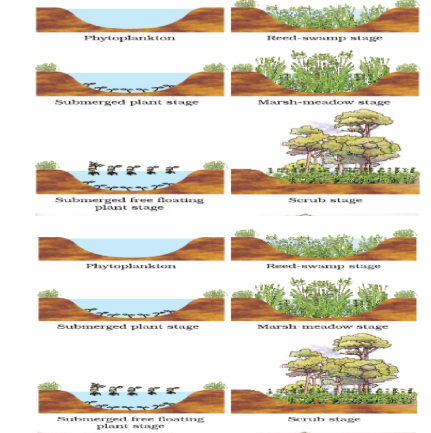
Succession of Plants
- Based on the nature of the habitat – whether it is water (or very wet areas) or it is on very dry areas – succession of plants is called hydrach or xerarch, respectively.
- Hydrarch succession takes place in wetter areas and the successional series progress from hydric to the mesic conditions. As against this, xerarch succession takes place in dry areas and the series progress from xeric to mesic conditions. Hence, both hydrarch and xerach successions lead to medium water conditions (mesic) – neither too dry (xeric) nor too wet (hydric).
- The species that invade a bare area are called pioneer species. In primary succession on rocks these are usually lichens which are able to secrete acids to dissolve rock, helping in weathering and soil formation. These later pave way to some very small plants like bryophytes, which are able to take hold in the small amount of soil. They are, with time, succeeded by bigger plants, and after several more stages, ultimately a stable climax forest community is formed.
- The climax community remains stable as long as the environment remains unchanged. With time the xerophytic habitat gets converted into a mesophytic one.
- In primary succession in water, the pioneers are the small phytoplanktons, they are replaced with time by free-floating angiosperms, then by rooted hydrophytes, sedges, grasses and finally the trees. The climax again would be a forest. With time the water body is converted into land.
- In secondary succession the species that invade depend on the condition of the soil, availability of water, the environment as also the seeds or other propagules present. Since soil is already there, the rate of succession is much faster and hence, climax is also reached more quickly.
- What is important to understand is that succession, particularly primary succession, is a very slow process, taking maybe thousands of years for the climax to be reached. Another important fact is to understand that all succession whether taking place in water or on land, proceeds to a similar climax community – the mesic.
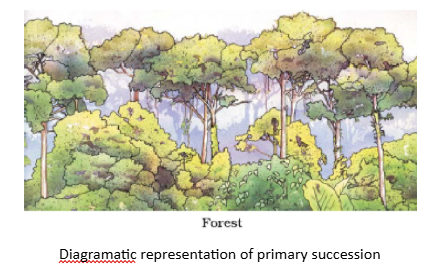
Frequently Asked Questions
Microbes are microscopic living organisms such as bacteria, fungi, protozoa, and some algae, along with viruses (which are acellular).
- Lactic acid bacteria (LAB): Convert milk into curd, improve nutrition, and inhibit harmful microbes.
- Yeast (Saccharomyces cerevisiae): Used in bread making, alcoholic fermentation in beverages.
- Fermentation: Microbes are used in making idli, dosa batter, cheese, vinegar, etc.
- Alcoholic beverages – Saccharomyces cerevisiae for wine, beer, whiskey.
- Antibiotics – Penicillium notatum produces penicillin.
- Organic acids – Aspergillus niger (citric acid), Acetobacter aceti (acetic acid), Clostridium butyricum (butyric acid).
- Enzymes – Streptokinase (clot buster), Lipase (detergent industry).
- Primary treatment: Removes large particles.
- Secondary treatment: Aerobic microbes digest organic matter, forming activated sludge.
- Anaerobic digesters: Methanogens produce biogas from sludge.
Methanogens (e.g., Methanobacterium) break down organic matter in anaerobic conditions to produce methane-rich biogas.
- Bacteria – Rhizobium (nitrogen fixation in legumes), Azotobacter, Azospirillum.
- Cyanobacteria – Anabaena, Nostoc, Oscillatoria.
- Fungi – Mycorrhiza (Glomus species) enhance water and nutrient absorption.
- Bacillus thuringiensis (Bt) – Produces insecticidal proteins for pest control.
- Trichoderma – Free-living fungus, used against plant pathogens.
- Ladybird beetle & dragonfly – Control aphids and mosquitoes.
A genetically modified plant containing the Bt toxin gene from Bacillus thuringiensis to resist bollworm pests.
Yes. Some cause diseases (e.g., Mycobacterium tuberculosis, Plasmodium), spoil food, or contaminate water. The same group of microbes can have both beneficial and harmful members.
They are crucial in food production, medicine, environmental cleanup, energy production, and sustainable agriculture.